Author Christine Heinrichs recently visited Mudchute Farms and the Dorking Museum in England, sites dedicated to preserving English chicken breeds and history. Read about her adventures in this conversation with Community Chickens Managing Editor Carla Tilghman.

This historic railway sign attests to Dorking’s long history as a market town, known for its chickens.
The Adventure Begins
Carla: How did you decide to visit England and especially English chickens?
Christine: I’ve been an Anglophile since I discovered Sherlock Holmes stories as a teenager: the mists swirling across the moors, carrying the howls of ghostly hounds. Agatha Christie’s mysteries followed, leading me down the garden path of village intrigue. James Herriott’s tales of veterinary adventures in rural Yorkshire introduced the human aspects of barnyard drama. When I first read those stories, such heartfelt conflicts and healing resolutions, played out in our love of animals, I thought they were true.
Fortunately, I managed to separate fiction from reality as I delved into England’s proud history with fowl of all kinds.
My husband and I decided to visit England this year. We’d join a tour for historic sites, and take time on our own to visit other poultry keepers and sites. Our chosen sites were Mudchute Farm in London and the Dorking Museum and Heritage Center southwest of London.
Carla: Are there breeds that are recognized as “English” chicken breeds?
Christine: The American Poultry Association has an entire classification of chickens designated English: the Redcaps, Cornish, Orpingtons, Sussex, Australorps and, my personal favorite, Dorkings. Old English Games Carry the sporting history. These glorious breeds remain prominent among English fanciers, who keep and influence the entire range of poultry.
Some ducks are also directly English, the Aylesbury and Silver Appleyard. The names themselves carry a whiff of English gardens and Victorian market days.
Exotic breeds hark to England’s maritime past. The arrival of a ship from lands across the sea, bearing exotic treasures to dazzle country life often included colorful fowl from Asia such as Javas and Oriental breeds. American introduced England to turkeys.
England’s history is inevitably entwined with that of the Continent. It’s as current as this morning’s news, as England seeks to disentangle itself from the European Union. Brexit will never cancel the Mediterranean and Continental breeds that have been the focus of so many breeders over the years. Northern Europe’s Hamburgs, Campines, Lakenvelders, Barnevelders and Welsummers. Polish, bearded and Non-bearded. The French Houdans, Faverolles, Crevecoeurs, LaFleche and Marans.
England’s history can be told through its poultry.
Rare Breeds Survival Trust
Carla: In the U.S., the Livestock Conservancy works to recognize and protect rare or threatened animal breeds. Is there a similar organization in England?
Christine: Yes! The Rare Breeds Survival Trust monitors rare and native breeds, collecting data from breed societies. They also collect genetic material from animals which are saved in the UK National Gene Bank as well as promote and support the breeding of native breeds. These breeds represent an important part of natural habitats and crucial biodiversity.
Mudchute Farm
Carla: One of the farms you visited, Mudchute Park and Farm, works with the Trust?
Christine: Indeed. Mudchute is a fascinating story. We traveled by tube from our hotel. We followed the signs to the farm and park. The entrance was green and overgrown, beckoning us onto the steps into what felt like a secret garden.
They currently breed cows, pigs, sheep, goats, chickens, ducks and turkeys, focusing mostly on English heritage breeds.

Mudchute Farm is a quiet enclave within London.
Carla: How did they end up having a farm in London?
Christine: It started with an effort from residents living in and around the London docklands who wanted to preserve land rather than allow business executives to build high-rises. Local residents organized against developing it into housing. They stepped up to resist urban development. Eventually, they gathered enough support that the 32-acre site was turned into a Peoples Park. In 1977, they formed the Mudchute Association, which still governs the park today.
From a piece of derelict land that developers envisioned as a high-rise apartment building site, it is now a verdant retreat of rural peace, recognized by the Rare Breeds Survival Trust for its heritage livestock.
Carla: The Docklands area along the Thames certainly has a long and varied history. Especially surviving the bombing during WWII.
Christine: Mudchute seems like a village farm that has existed forever, even though it’s modern. The site itself is 32-acres on the Isle of Dogs, an oxbow island formed by the River Thames. It takes its name from the mud dredged up over the past century at Millwall Dock in the 1890s. The smell was the subject of local comment. Soccer (English football) players complained that they stank for weeks if they fell down while playing on the sort field built there.
The docks were a bustling economic engine for London in the 19th and early 20th centuries.
The docks were heavily bombed during World War II. Anti-aircraft artillery remains on the property. Mudchute became part of the Home Front, London’s defense to the Nazi Blitzkrieg. An anti-aircraft gun, an Ack-Ack Gun, remains as a reminder at the farm. A video on that part of its history is posted on YouTube.

Mudchute’s Ack-Ack Gun is a reminder of British resistance to Nazi bombing.
Although London and the docks recovered, the docks were made obsolete by container shipping. The area fell into decline. Remember East Enders, the English television series in the 1980s? It dramatized the issues of low income, unemployment, crowded living conditions of southeast London.
Carla: Wow! That really shows how amazing the development of Mudchute Farm is.
Christine: Absolutely! It’s a testament to the power of local people who insist on preserving local treasures.
Carla: Who manages the farm now?
Christine: The Mudchute Association found a livestock leader in Tom Davis who is the Farm, Park and Open Space Manager.
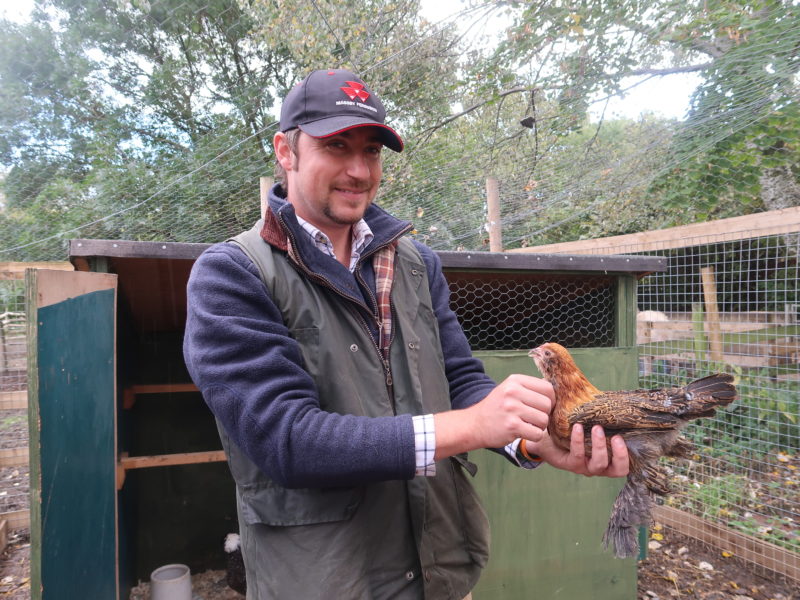
Tom Davis shows off one of his d’Uccles.
Tom grew up in urban Battersea, in southwest London, but felt farming calling to him as a child, on his visit to the local farm park. He studied agriculture, and at 18 became Mudchute’s farm manager in 2004. After five years at Mudchute, he moved on to gain experience at a farm specializing in helping children with behavioral problems, then a facility that he stocked with rare breeds. He returned to Mudchute in 2016 with those additional qualifications.
Now 33, Tom has been back at Mudchute since 2016. He became a rare breed sheep judge and serves on the board of trustees for the RBST and on the national council for the British Waterfowl Association.
Carla: What has he been focusing on at Mudchute since his return?
Christine: He has assembled RBST breed livestock of all kinds at Mudchute. For chickens, he’s got Red and Dark Dorkings, both single comb and rosecomb in the Dark, large exhibition quality Light Sussex, Orpingtons, Silver Dutch, large Dark and Jubilee Indian Games, Silver Marans, Millefleur and Porcelain dUccles, and various pet quality Polish.
Tom also has a special interest in waterfowl, and is raising Runner ducks, Aylesburys, Rouens, and Calls. The flock includes two sweet Muscovy hens for hatching. For geese, he keeps Steinbachers and Brown Chinas.
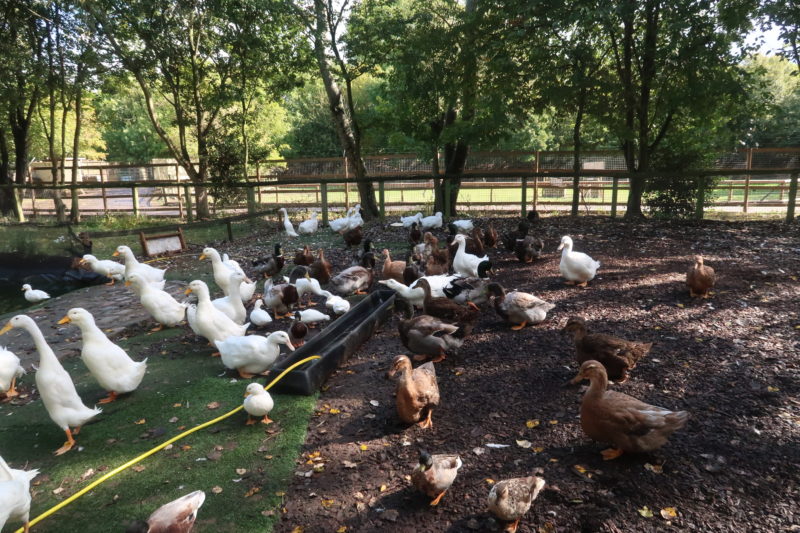
Mudchute’s mixed waterfowl flock live together amicably.
Carla: What did you and your husband particularly notice and enjoy during your visit to Mudchute?
Christine: The site felt enchanted, this oasis of green English farm on the edge of the city, with the skyline in view. After a lunch in a stylish restaurant (buttermilk curry for me, fish pie for my husband), we were drawn to the river. Commuter boats skim up the Thames. We gazed at the Houses of Parliament, as the debate on Brexit raged on. In our Tottenham Court Road hotel, we heard sirens screaming and saw emergency vehicle lights flashing as the police responded to Extinction Rebellion protesters.
At Mudchute, those issues are as urgent and pressing as in the rest of the world. Tom is working with developers who plan thousands more housing units around the farm, which he anticipates will overwhelm it. He and the board are negotiating for funds and support to manage the impact of so many more visitors. They hosted 30,000 school children in 2018, and aim for that many again this year.
Yet the farm itself, its presence and dedication to saving and showcasing historic breeds that are now rare, is a powerful asset. Every visitor learns something, connects with the poultry, the donkeys, the hogs. That influence will be invaluable in building support for the better world we all want to live in.
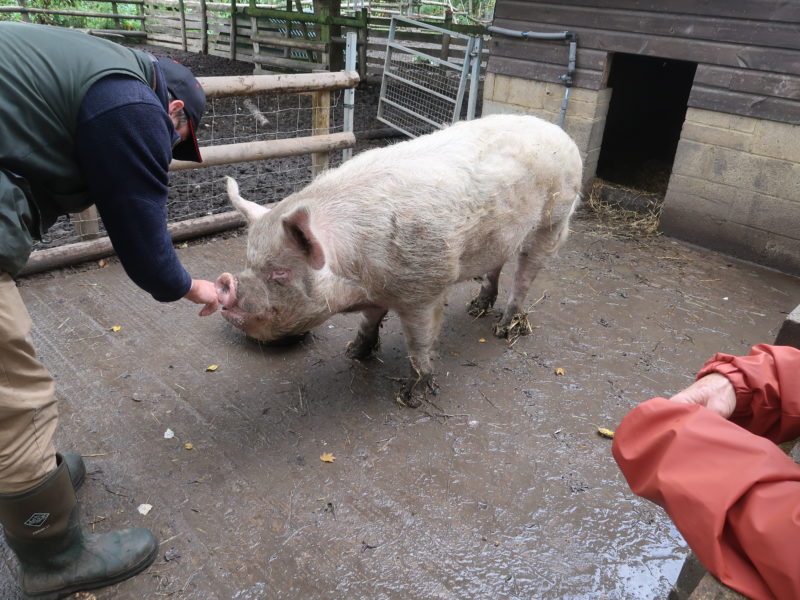
Tom and George, the Middlewhite boar, share a morning greeting.
Heading to Dorking
Carla: After Mudchute, you traveled southwest to Dorking where the Dorking Museum is.
Christine: Yes. We took the train. Looking out at the landscape rushing past, I saw a large red fox watch the train go by. Experienced Dorking breeder Terry Dunk later told me that foxes are the worst poultry predators for English flocks. English foxes become quite tame around people. The one I saw certainly considered the train part of his regular habitat.
Carla: You mentioned when we were chatting earlier, that you had some unexpected adventures when you first got to Dorking.
Christine: We were instantly recognizable as Americans and when we were switching to the local bus, we met Canon Peter Bruinvels, Armed Forces Champion 11 X Brigade SE and HQ SE and Surrey CC Civilian-Military Liaison Adviser, who happened to be taking the same bus as we were.
Peter is a natural greeter, and he engaged us in conversation. As soon as he heard our mission to visit the Dorking Museum & Heritage Center, he took it as his personal responsibility to extend Dorking’s hospitality to us.
He hailed the bus driver to slow down as we passed the roundabout entering town, with its iconic Dorking statue. Instead of letting us take the bus directly to the museum, he invited us to get off at an earlier stop, so he could lead us on a walking tour of some of Dorking’s many features.
He brought us to St. Martin’s Church, where the priest was holding an outdoor service in honor of St. Anthony, Blessing the Animals. On this day, several dogs attended to receive their blessings.
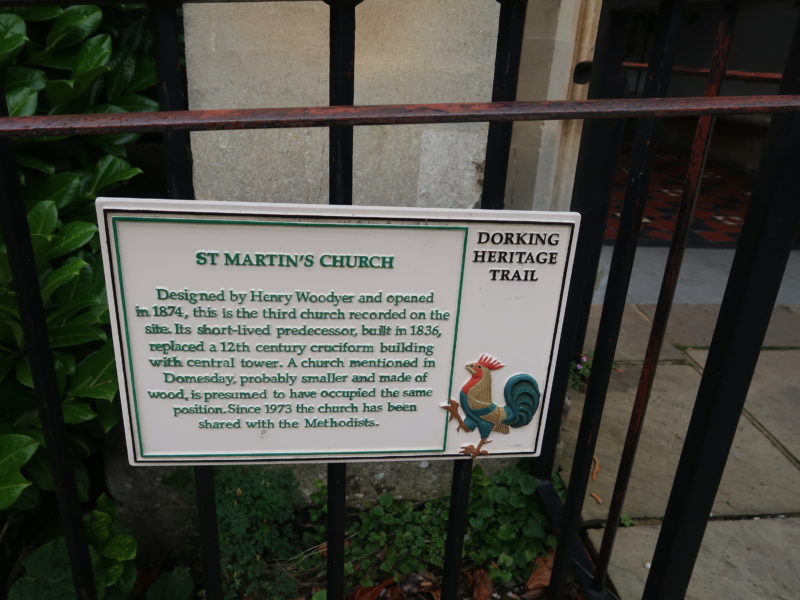
St. Martin’s is the most recent of churches that have occupied the site for centuries.
“I am very proud of Dorking, having been born here over 60 years ago,” he told us. He showed us the baptismal font in St. Martin’s where he was baptized. The soprano was rehearsing her solo for the Sunday church service.
Dorking Museum and Heritage Center
Carla: What a lovely introduction to the city! What led you to want to go to Dorking in the first place?
Christine: While we were part of an organized tour for much of our England visit, I have wanted to go to Dorking for ages. I missed an opportunity to confer with Terry Dunk, an experienced Dorking breeder, but we now correspond via email.
I wanted to learn more about both the long history of the area itself and its connection to the Dorking chicken breed, one of the oldest continuous chicken breeds in existence today. It’s possible that the Romans brought the original stock to England when they really moved into the British Isles after 43 AD. The five-toed birds are named after the town and were long considered the finest table birds.
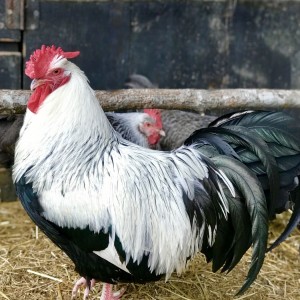
Dorkings are a foundation chicken breed.
After showing us around the city, Peter brought us through Dorking’s ancient lanes, the back way, to our destination. Visitors arriving at the front find their way guided by dinosaur footprints painted on the pavement, which gradually evolve into chicken footprints at the museum’s entrance.
A perfect invitation, as Dorking’s museum traces local history back to the Cretaceous, 130 million years ago, and its dinosaurs. Peter handed us off to Robin Cooper at the museum. He was our guide, well informed on every aspect of Dorking’s long and distinguished history.
A pair of stuffed Dorking chickens is the first display visitors see.

The Dorking Museum features its iconic chicken breed, in its setting of history and even prehistory.
Carla: What have excavations in Dorking revealed about the history of the area?
Christine: Local excavations have turned up dinosaur fossils from 100 million years ago. Human hunter-gatherers left evidence of their presence in charred hazelnuts, dated to 10,000 years ago, and a fire pit back 6,000 years. Arrow heads and axes 4,000-6,000 years old turn up in Dorking gardens. Many Iron Age artifacts 3,500-5,000 years old have been found.
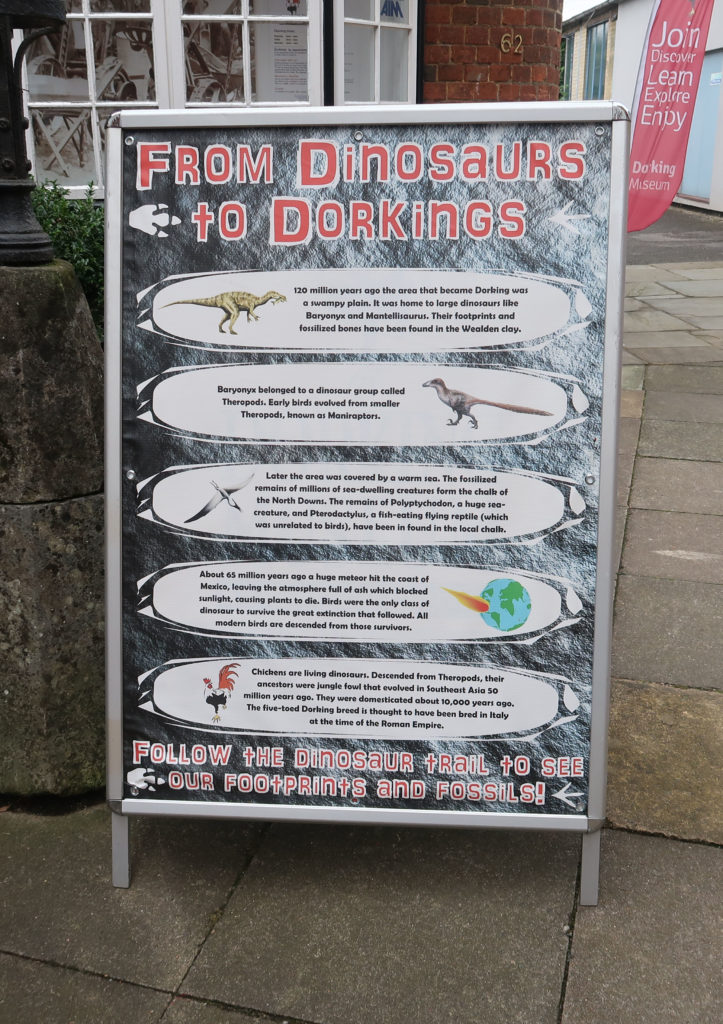
The Dorking Museum takes a long view of history.
Into historical times, the museum has connections to the Knights Templar of the 12th century, and Pilgrim Mother Priscilla Mullins, who came to the New World on the Mayflower in 1620 and married John Alden. The Mullins name is still well known in Dorking. After our tour, we left Robin and the museum to have tea and cakes at Mullins Coffee Shop, located in the building that was the Mullins family home.
Dorking residents are chronicled for their involvement in two World Wars. Suffragettes fought for the vote. The adventurous took to riding bicycles when they came on the scene, and then autos. The railway improved trade.
Refugees have found their way to Dorking through the years. Now, the town welcomes Syrians escaping the civil war there.
Carla: That’s a lot of history packed into a small area!
Christine: We were so impressed by everything we saw and the people we met. Think about it: Pilgrims left for the New World, suffragettes fought for the vote, they fought through two World Wars.
Robin showed us his ration card, issued when he was a child and Peter told us that the local MP, Conservative Peter Beresford, visits frequently to talk with constituents. We met him on the High Street!
Carla: How does the museum work to preserve the history of the chicken breed?
Christine: Among other efforts, the museum has its own publishing arm, Cockerel Press, which has published 14 books, including The Dorking Cockerel, a history of its namesake chicken, and Time Gentlemen, Please, an account of its pubs, featuring an image of a Dorking cock on the cover. Dorking presently has only 18 public houses, down from a high of 104, Robin told us. The pubs also had pits for cock fighting, another popular pastime.

A pair of stuffed Dorkings is the first exhibit greeting visitors to the museum.
Carla: Christine, thank you so much for sharing your England adventure with us. We’ll include links to the many resources you’ve mentioned so our readers can learn more about both Dorking chickens and breed conservation efforts in England. I hope you’ll get to return to England soon.
Christine: Thank you. Yes, after our visit to the museum, we strolled back to the train station along the High Street, soaking up the ambiance of this beautiful and classic English town. I felt guided by chickens, my Spirit Animal, on this visit of the heart.
Christine Heinrichs writes from her home on California’s Central Coast. She keeps a backyard flock of a dozen hens, eight large fowl of various breeds and four bantams.
Her book, How to Raise Chickens, was first published in 2007, just as the local food movement was starting to focus attention on the industrial food system. Backyard chickens became the mascot of local food. The third edition of How to Raise Chickens was published in January 2019. The Backyard Field Guide to Chickens was published in 2016. Look for them in the Community Chickens online store and at Tractor Supply stores.
She has a B.S. in Journalism from the University of Oregon and belongs to several professional journalism and poultry organizations.
Carla Tilghman is Managing Editor for Community Chickens, Keeping Backyard Bees, Herbal Living, Homestead Hustle and the Mother Earth News and Friends Podcasts. When not frantically reading everything she can find on chickens, herbs and bees, Carla looks after her chickens, cats, family and makes time for weaving, knitting and nålbinding.













1 Comment
Love the article. Been to all sites featured.
The rosecomb silver grey Dorking male is ours and photo is one I shared with the Livestock Conservancy. They have hence removed our photo and replaced with another example of the breed, albeit a v poor one.
We keep 7 Dorking varieties at Moss Mountian Farm.
Thank you for your advocacy.
PAS